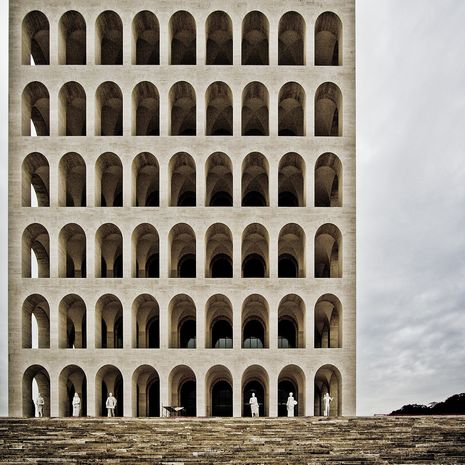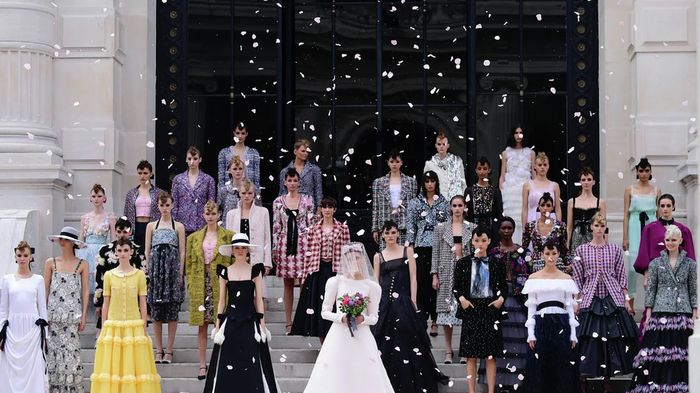Marble, mosaics, and Medea: Fendi Fall/Winter 2021 haute couture
Columnist Ava Wilson reviews the classical references and powerful vision of women in Fendi’s Fall/Winter 2021 Haute Couture

Rome, late Autumn. The sun sets over the Palazzo della Civiltà Italiana, casting pink and orange hues over the Carrara marble statues lining the colonnade. It is here, at Fendi’s international headquarters, that we see the inspiration for the Fall/Winter 2021 Haute Couture collection: the softness of the light expressed in silk and feathers, the solidity of the statues channelled in marble jewellery, and the fading light imitated with a pastel and grey-toned palette.
This is Kim Jones’s debut collection with the brand. Until now a menswear designer, this represents his transition to womenswear, and is his first time working with an Italian fashion house. Rich in classical iconography, the collection represents an attempt to connect not just with the Fendi label, but also its Roman roots.
The set is closely inspired by the architecture of the Palazzo. Nicknamed the ‘Square Colosseum’, it provides a classically-inspired backdrop for Jones’s collection. Furthermore, it alludes to the final collection of his predecessor Karl Lagerfield, which was staged in front of the Roman Colosseum itself. Jones is situating himself firmly in place, spatially and temporally, looking both to the past and to his future work.
“Jones is situating himself firmly in place, spatially and temporally, looking both to the past and to his future work”
The collection is an expression of the afterlife of classical Rome in the modern city. One dress is embroidered with swirling feathers, like Roman martial helmet plumes. A jacket is studded with recycled fur pieces, patterned in the style of a mosaic. A silk ball gown swirls with marble veins — it is stone in fluid motion.
The jewellery is no less classical. There are earrings, bracelets and necklaces of Italian Carrara marble, the same material as the statues poised outside the building. The models are like sculptures come to life. The amphora is reimagined as an earring. Rebranded as the amFFora by designer Delfina Delettrez-Fendi, its signature curved handles are replaced with double Fendi Fs.
One particularly striking necklace features clusters of tiny tile mosaics. The largest and most central pane features the image of a sparrow, a classical symbol of female love and desire. It was widely associated with the goddess of love, Venus, and was popularised in Rome through the poetry of Catullus. Even the heels of the shoes form part of this network of visual allusions, combining the Fendi F with two arches — symbolic of both the arches lining the Palazzo and the hills of Rome.
Kim Jones’ vision of Rome is filtered through its Renaissance legacy. This provides the perfect framework for his venture to reinvent the ancient city through the modern and bring together the old Fendi with the new. Classical statuary is represented in white marble and grey-toned silk, reflective of how surviving classical sculptures, and their Renaissance imitations, look in museums today. However, this is a far cry from how statues would have looked in classical Rome, their brightly painted colours washed away over time.
Some dresses are toga-inspired, while other pieces have Renaissance silhouettes — with drawstring cuffs and high, upturned jacket collars. Flowers and leaves are embroidered in lace, like the frame of a Titian painting, or a Della Robbia sculpture, or an illuminated manuscript page. The crowning jewel of the collection is a light grey ball gown, worn by Olympic athlete Allyson Felix at the Met Gala. The dress floats like a cloud: soft, airy, and embellished with hundreds of gently-floating ostrich feathers, a nod to 15th century finery.
Kim Jones incorporates a third layer of reference by drawing inspiration from Pasolini. Jones explains the importance of this connection in his show notes: “Pasolini observed Rome becoming modern — and that is what is interesting to me: connecting eras, the old with the new, the past with the present.”
In a 2013 article on Pasolini, Professor Patrick Rumble explains the key elements of the filmmaker’s style, explaining both the significance of his “highly cultivated repertoire of visual vocabularies and iconographic traditions inherited from the past” and his “practice of melding various styles and traditions.” Pasolini’s style has had a clear influence on Jones’s approach. In an interview with Loic Prigent, Jones describes how he drew not just stylistic, but also visual inspiration from Pasolini: “when you look at the Pasolini films, the colours are very washed out, it feels very natural, organic, and Roman.”
“He seeks to celebrate four successive generations of female Fendi family designers”
In the same Loic Prigent interview, Jones expresses his desire to develop “the new Fendi woman”, creating a modern vision of her style and illustrating the roots from which it has evolved. Writing that story, and putting it on a stage, are important to his work.
He seeks to celebrate four successive generations of female Fendi family designers. Delfina Delettrez-Fendi, designing jewellery for the collection, carries on her great-grandmother’s legacy. Delfina’s mother, Silvia Venturini Fendi explains the influence of Pasolini’s Medea. The soprano Maria Callas’s titular performance was crucial to the the development of the (metaphorical) female voice in film of the collection:
“We were watching Salo for the colours, we were watching Medea, for the woman, Maria Callas, we wanted those women [the models] to be almost surreal, like opera singers […] we want it to be a performance, a theatrical performance.”
Eternal city, eternal woman: Kim Jones melds modern and classical styles to reinvent the Roman woman. Both donna and domina, she takes centre stage.
 News / SU reluctantly registers controversial women’s soc18 December 2025
News / SU reluctantly registers controversial women’s soc18 December 2025 Features / Should I stay or should I go? Cambridge students and alumni reflect on how their memories stay with them15 December 2025
Features / Should I stay or should I go? Cambridge students and alumni reflect on how their memories stay with them15 December 2025 News / Dons warn PM about Vet School closure16 December 2025
News / Dons warn PM about Vet School closure16 December 2025 News / Cambridge study finds students learn better with notes than AI13 December 2025
News / Cambridge study finds students learn better with notes than AI13 December 2025 Fashion / The art of the formal outfit 18 December 2025
Fashion / The art of the formal outfit 18 December 2025









